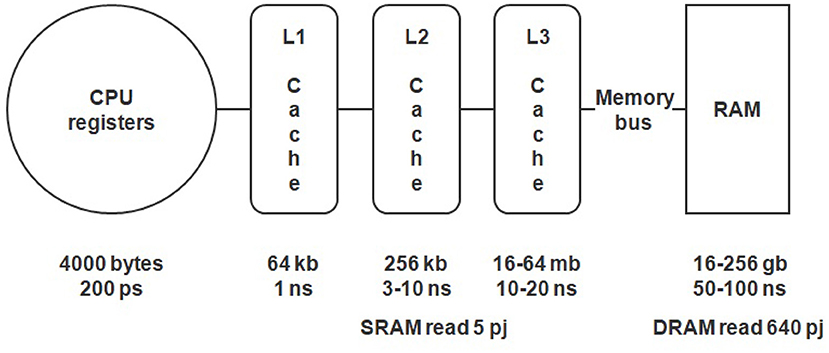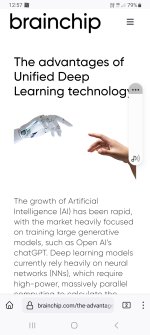You are using an out of date browser. It may not display this or other websites correctly.
You should upgrade or use an alternative browser.
You should upgrade or use an alternative browser.
BRN Discussion Ongoing
- Thread starter TechGirl
- Start date
HopalongPetrovski
I'm Spartacus!
New interview with Nanden.
Another competent, assured, confident and personable individual getting the word out.
Feels like we are getting close to a turning point now.
So many areas we can add benefit too, and as uptake begins, you can just see exponential growth written all over it.
BrainChip is staying the course. We who are locked and loaded, just have to, as well.
AKIDA BALLISTA
AKIDA EVERYWHERE
GLTAH
The Renesas AKIDA chip should be off the production line this month or August.One announcement away from kaboom!!!!
Accumulated as much as I can, might pick-up a few more early next week, then going to sit back with the popcorn and watch the show....
Yeaaaaaaaah...
News appeared in eenewseurope on the 2nd Dec'22 so end of July sees 8 months since it was Taped out.
Can't be long now.
We probably will not see an ASX ann but we will likely see a US ANN.
Renesas are obviously producing the chip for Commercial purposes.
When it's available for Renesas clients I would hope we see a rise in the SP.
It's wait and see.
Polyn.ai , anyone got further evidence of Akida apart from the usual wording?
View attachment 39445
"ANALOG"
WO2021262023A1 ANALOG HARDWARE REALIZATION OF NEURAL NETWORKS
NASA like analog because it is radhard.
thelittleshort
Top Bloke
This is crazy...
@Labsy - I found this a while back. Vi Nguyen Thanh Le won an award for her efforts
Last edited:
The Renesas AKIDA chip should be off the production line this month or August.
News appeared in eenewseurope on the 2nd Dec'22 so end of July sees 8 months since it was Taped out.
Can't be long now.
We probably will not see an ASX ann but we will likely see a US ANN.
Renesas are obviously producing the chip for Commercial purposes.
When it's available for Renesas clients I would hope we see a rise in the SP.
It's wait and see.
buena suerte :-)
BOB Bank of Brainchip
Tothemoon24
Top 20
Drones to monitor traffic congestion in Seoul
Drones will start hovering over Seoul to monitor traffic congestion more accurately and even predict road conditions, according to the city government on Monday.
Starting in September, the machines will fly up to 230 meters over the city to see where traffic jams are occurring, according to the City Transportation Office under the Seoul Metropolitan Government.
The authority said the drones will enable more advanced traffic monitoring as they can watch hundreds of vehicles in motion from high above simultaneously.
The flying eyes can also single out a certain vehicle to study it and, depending on ambient traffic conditions, calculate possible routes the vehicle may take. Considering that multiple drones can have such data collected from hundreds of other vehicles across the city in real time, it can help traffic flow more efficiently.
Such a feature is out of the question with conventional methods using stationary surveillance cameras that are positioned just a few meters above the ground ― giving only a low-altitude view of traffic.
Another merit of drones is their artificial intelligence that will automatically read traffic movements, carry out calculations and present traffic data.
The machines can also record videos. This recorded data will be transferred in real time to the Seoul Transport Operation & Information Service (TOPIS), the city's central traffic monitoring center. The command center, upon receiving the data, can make necessary decisions depending on real-time traffic conditions and pop-up notifications on electronic display boards visible to drivers along roads and city highways.
Such a method beats the traditional ground-based cameras which are not capable of analysis and thus require humans to monitor and analyze the video feeds.
The upcoming strategy for Seoul TOPIS is expected to help the city authority greatly in cases where spontaneous decision-making is often required, like watching over large-scale rallies, marathons, parades and outdoor concerts in areas shared by vehicles.
City Transportation Office Chief Yoon Jong-jang said that the implementation of drones into the city's comprehensive traffic control system will strengthen further the ways the city responds in real time to road conditions as well as large-scale events.
"The city government's traffic administration will keep pursuing scientific breakthroughs to improve the quality and safety of citizens," said Yoon.
Falling Knife
Regular
View attachment 39461
@Labsy - I found this a while back. Vi Nguyen Thanh Le won an award for her efforts
View attachment 39460
Great connections, May I add a third incredible coincidence/connection in relation to this beast of a machine is discussed by Nandy at 19:50
Lawn mower with weed killing capabilities.
I love how long and hard he thought about the example to give...
Do ya think there are so many he could choose from his brain had difficulty processing the full list so as to offer the one which would have the smallest chance of giving away the customer associated with it... John Deer back on the cards lol
Boab
I wish I could paint like Vincent
AgreedGreat connections, May I add a third incredible coincidence/connection in relation to this beast of a machine is discussed by Nandy at 19:50
Lawn mower with weed killing capabilities.
I love how long and hard he thought about the example to give...
Do ya think there are so many he could choose from his brain had difficulty processing the full list so as to offer the one which would have the smallest chance of giving away the customer associated with it... John Deer back on the cards lol
It was almost as if we was going to tell a lie and had to word it in such a way as to stay honest.
I really do enjoy Nandan's talks very much.
Taproot
Regular

Carbon Robotics: First & Only Commercial LaserWeeder™
Carbon Robotics builds the industry-leading AI-powered LaserWeeder™. LaserWeeder combines computer vision, AI deep learning technology, robotics, and lasers to identify crops versus weeds - and shoots the weeds with lasers. LaserWeeding cuts weed control costs by 80%, boosts crop yield and quality,
Carbon Robotics™ is pioneering the next revolution in agricultural technology: laserweeding.
Weed control is one of farming’s biggest headaches. By leveraging artificial Intelligence and laser technology, Carbon Robotics delivers chemical-free, no-till, weed control for specialty crops. Our hi-resolutions cameras feed imagery in real time to an onboard supercomputer that runs computer vision models to identify crops and weeds. High-powered lasers then kill weeds at the meristem — without harming valuable crops. Laserweeding works day or night, in all weather conditions. It’s a high-precision solution that improves crop yield and reduces overall costs associated with modern farming. Additionally, laserweeding creates sustainable paths to regenerative and organic farming.
ARTIFICIAL INTELLIGENCE
- Powered by Nvidia GPUs
- High-resolution cameras targeting weeds
- Deep-learning-based computer vision models
TheFunkMachine
seeds have the potential to become trees.
Just to repost a collection of previous posts, could it be we might be closely tied to Samsung for akida2 ?
Posted by IloveLamp.
View attachment 39419
The Akida image is from (1:10) from the below link compared next to an image of a BMW interior.
View attachment 39426
Image shown below is the old iDrive. Akida possibly part of the newer infotainment system to be released? The new vehicles will also contain occupant monitoring and external sensors controlled by an NPU.
View attachment 39424
Predicted partnership
View attachment 39420
To add further; Exynos has been linked with Hyundai and Volkswagen.
Old hand gesture dataset for some added spice. (Also previously posted by another user)
View attachment 39422
Attachments
What a great spokesman for Brainchip Nandan is! I did notice in the interview, there is a John Deere tractor on the shelf behind the interviewer/podcaster. Easter egg or coincidence??Agreed
It was almost as if we was going to tell a lie and had to word it in such a way as to stay honest.
I really do enjoy Nandan's talks very much.
If you don't have dreams, you can't have dreams come true!
If it uses Nvidia's GPU, you wouldn't need the laser, the heat would do the job.
Carbon Robotics: First & Only Commercial LaserWeeder™
Carbon Robotics builds the industry-leading AI-powered LaserWeeder™. LaserWeeder combines computer vision, AI deep learning technology, robotics, and lasers to identify crops versus weeds - and shoots the weeds with lasers. LaserWeeding cuts weed control costs by 80%, boosts crop yield and quality,carbonrobotics.com
Carbon Robotics™ is pioneering the next revolution in agricultural technology: laserweeding.
Weed control is one of farming’s biggest headaches. By leveraging artificial Intelligence and laser technology, Carbon Robotics delivers chemical-free, no-till, weed control for specialty crops. Our hi-resolutions cameras feed imagery in real time to an onboard supercomputer that runs computer vision models to identify crops and weeds. High-powered lasers then kill weeds at the meristem — without harming valuable crops. Laserweeding works day or night, in all weather conditions. It’s a high-precision solution that improves crop yield and reduces overall costs associated with modern farming. Additionally, laserweeding creates sustainable paths to regenerative and organic farming.
ARTIFICIAL INTELLIGENCE
- Powered by Nvidia GPUs
- High-resolution cameras targeting weeds
- Deep-learning-based computer vision models
This is crazy...
Can they make one for Shorters?
From Sept 22, sorry if already posted.

 www.frontiersin.org
www.frontiersin.org
Snippet:-
3.8. Akida
Akida (Vanarse et al., 2019) is the first commercial neuromorphic processor, commercially available since August 2021. It has been developed by Australian BrainChip since 2013. Fifteen companies, including NASA, joined the early access program. In addition to Akida System on Chip (SoC), BrainChip also offers licensing of their technologies, providing chip manufacturers a license to build custom solutions.
The chip is marketed as a power efficient event-based processor for edge computing, not requiring an external CPU. Power consumption for various tasks may range from 100 μW to 300 mW. For example, Akida is capable of processing at 1,000 frames/Watt (compare to TrueNorth with 6,000 frames/Watt). The first generation chip supports operations with convolutional and fully connected networks, with the prospect to add support of LSTM, transformers, capsule networks, recurrent and cortical neural networks. ANN network can be transformed into SNN and executed on the chip.
One Akida chip in a mesh network incorporates 80 Neural Processing Units, which enables modeling 1,200,000 neurons and 10,000,000,000 synapses. The chip is built at TSMC 28 nm. In 2022, BrainChip announced the second generation chip at 16 nm.
Akida's ecosystem provides a free chip emulator, TensorFlow compatible framework MetaTF for the transformation of convolutional and fully connected neural networks into SNN, and a set of pre-trained models. When designing a neural network architecture for execution at Akida, one should take into account a number of additional limitations concerning the layer parameters (e.g., maximum convolution size is 7, while stride 2 is supported for convolution size 3 only) and their sequence.
The major distinctive feature is that incremental, one-shot and continuous learning are supported straight at the chip. At the AI Hardware Summit 2021 BrainChip showed the solution capable of identifying a human in other contexts after having seen him or her only once. Another product by BrainChip is a smart speaker, that on having heard a new voice asks the speaker to identify and after that calls the person by their name. There results are achieved with help of a proprietary local training algorithm on the basis of homeostatic STDP. Only the last fully connected layer supports synaptic plasticity and is involved in learning.
Another instructive case from the AI Hardware Summit 2021 was a classification of fast-moving objects (for example, a race car). Usually, such objects are off the frame center and significantly blurred but they can be detected using an event-based approach.

Frontiers | Neuromorphic artificial intelligence systems
Modern AI systems, based on von Neumann architecture and classical neural networks, have a number of fundamental limitations in comparison with the brain. Th...
Snippet:-
3.8. Akida
Akida (Vanarse et al., 2019) is the first commercial neuromorphic processor, commercially available since August 2021. It has been developed by Australian BrainChip since 2013. Fifteen companies, including NASA, joined the early access program. In addition to Akida System on Chip (SoC), BrainChip also offers licensing of their technologies, providing chip manufacturers a license to build custom solutions.
The chip is marketed as a power efficient event-based processor for edge computing, not requiring an external CPU. Power consumption for various tasks may range from 100 μW to 300 mW. For example, Akida is capable of processing at 1,000 frames/Watt (compare to TrueNorth with 6,000 frames/Watt). The first generation chip supports operations with convolutional and fully connected networks, with the prospect to add support of LSTM, transformers, capsule networks, recurrent and cortical neural networks. ANN network can be transformed into SNN and executed on the chip.
One Akida chip in a mesh network incorporates 80 Neural Processing Units, which enables modeling 1,200,000 neurons and 10,000,000,000 synapses. The chip is built at TSMC 28 nm. In 2022, BrainChip announced the second generation chip at 16 nm.
Akida's ecosystem provides a free chip emulator, TensorFlow compatible framework MetaTF for the transformation of convolutional and fully connected neural networks into SNN, and a set of pre-trained models. When designing a neural network architecture for execution at Akida, one should take into account a number of additional limitations concerning the layer parameters (e.g., maximum convolution size is 7, while stride 2 is supported for convolution size 3 only) and their sequence.
The major distinctive feature is that incremental, one-shot and continuous learning are supported straight at the chip. At the AI Hardware Summit 2021 BrainChip showed the solution capable of identifying a human in other contexts after having seen him or her only once. Another product by BrainChip is a smart speaker, that on having heard a new voice asks the speaker to identify and after that calls the person by their name. There results are achieved with help of a proprietary local training algorithm on the basis of homeostatic STDP. Only the last fully connected layer supports synaptic plasticity and is involved in learning.
Another instructive case from the AI Hardware Summit 2021 was a classification of fast-moving objects (for example, a race car). Usually, such objects are off the frame center and significantly blurred but they can be detected using an event-based approach.
Attachments
Can they make one for Shorters?
buena suerte :-)
BOB Bank of Brainchip
Can they make one for Shorters?

Similar threads
- Replies
- 0
- Views
- 4K
- Replies
- 7
- Views
- 5K
- Replies
- 0
- Views
- 3K



